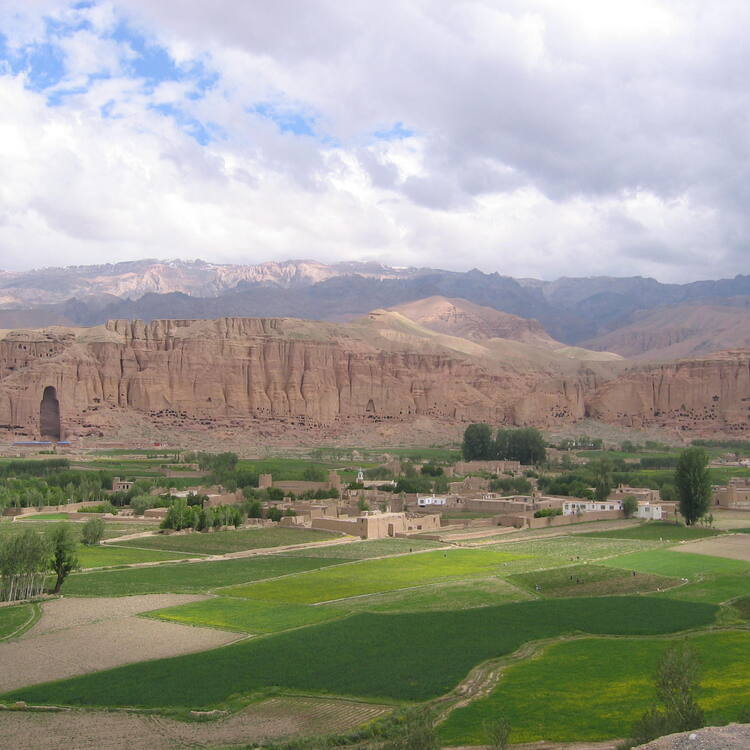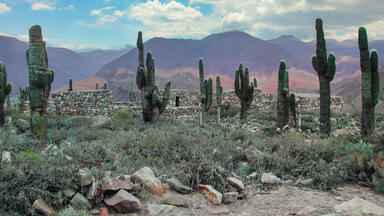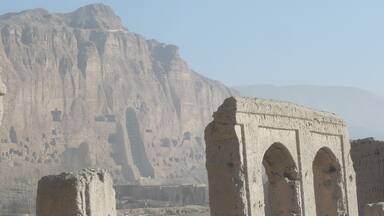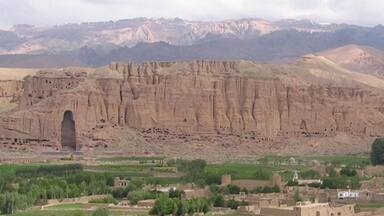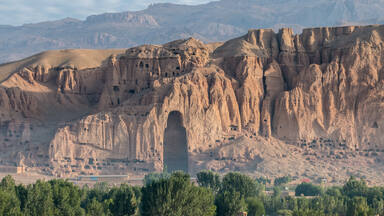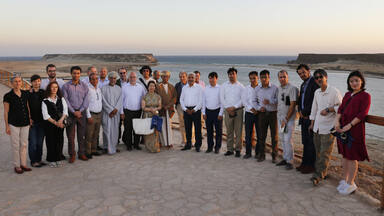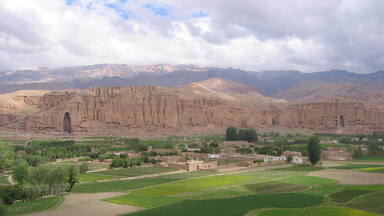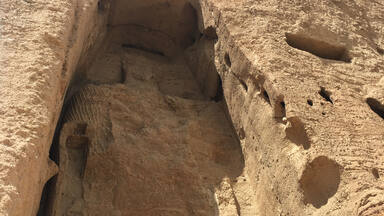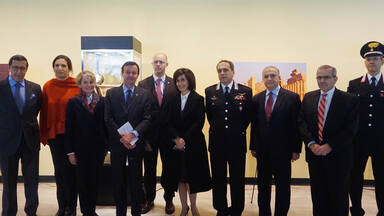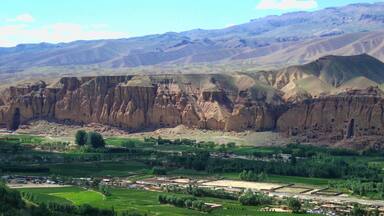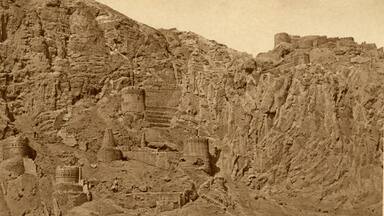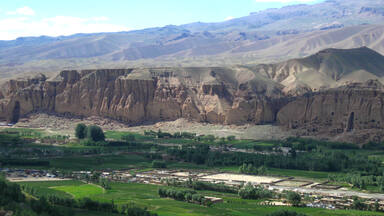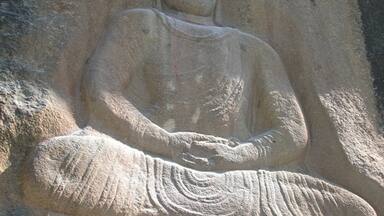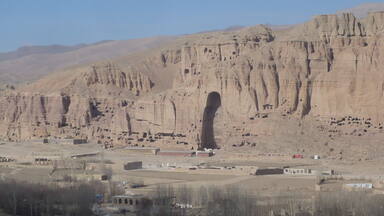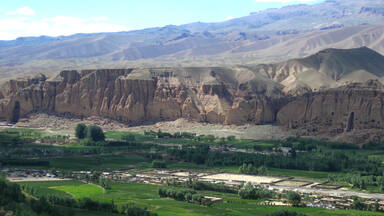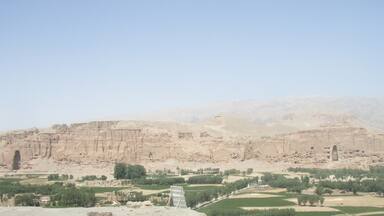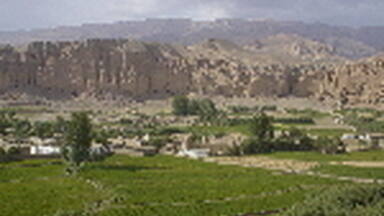Cultural Landscape and Archaeological Remains of the Bamiyan Valley
Cultural Landscape and Archaeological Remains of the Bamiyan Valley
The cultural landscape and archaeological remains of the Bamiyan Valley represent the artistic and religious developments which from the 1st to the 13th centuries characterized ancient Bakhtria, integrating various cultural influences into the Gandhara school of Buddhist art. The area contains numerous Buddhist monastic ensembles and sanctuaries, as well as fortified edifices from the Islamic period. The site is also testimony to the tragic destruction by the Taliban of the two standing Buddha statues, which shook the world in March 2001.
Description is available under license CC-BY-SA IGO 3.0
Paysage culturel et vestiges archéologiques de la vallée de Bamiyan
Le paysage culturel et les vestiges archéologiques de la vallée de Bamiyan illustrent les développements artistiques et religieux qui, du Ier au XIIIe siècle, ont caractérisé l’ancienne Bactriane, intégrant diverses influences culturelles pour former l’école d’art bouddhique du Gandhara. Le site contient plusieurs ensembles monastiques et sanctuaires bouddhistes, ainsi que des édifices fortifiés de la période islamique. Il témoigne également de la tragique destruction des deux bouddhas debout par les taliban, qui ébranla le monde en mars 2001.
Description is available under license CC-BY-SA IGO 3.0
المنظر الثقافي والبقايا الأثرية في وادي باميان
يمثّل المنظر الثقافي والبقايا الأثرية في وادي باميان التطوّر الفنيّ والدينيّ الذي ميّز (إمبراطورية) "بختريان" القديمة بين القرن الأول والقرن الثالث عشر، فاجتمعت التأثيرات الثقافية المختلفة لتثمر عن المدرسة البوذيّة الفنيّة في غاندهارا. يحتوي الموقع على مجمّعات رهبانية مختلفة ومقدّسات بوذية عديدة، بالإضافة إلى مبانِ معزّزة تعود إلى العصر الإسلامي. ويشهد الموقع أيضاً على الدمار المأساوي لتمثالي بوذا الواقفين، وهو دمار أقدم عليه الطالبان وهزّ العالم في آذار/ مارس من العام 2001.
source: UNESCO/CPE
Description is available under license CC-BY-SA IGO 3.0
巴米扬山谷的文化景观和考古遗迹
巴米扬山谷的文化景观和考古遗址向世人展示了从公元1世纪至13世纪期间以古代巴克特里亚文化为特征的艺术和宗教发展。正是在这一发展过程中,佛教艺术的干达拉流派兼收并蓄了各种文化影响。这一地区汇集了大量的佛教寺院、庙宇,以及伊斯兰教时期的防御建筑。此遗址同时也见证了塔利班政权无情摧毁两尊立佛像的暴行。这一事件在2001年3月曾震惊世界。
source: UNESCO/CPE
Description is available under license CC-BY-SA IGO 3.0
Культурный ландшафт и археологические находки в долине Бамиан
Культурный ландшафт и археологические находки в долине Бамиан иллюстрируют развитие искусства и религии древней Бактрии с I до XIII вв., где различные культурные влияния интегрировались в гандхарскую школу буддийского искусства. Район содержит множество буддийских монастырских ансамблей и святилищ, укрепленных зданий, относящихся к мусульманскому периоду. Этот объект был свидетелем трагического разрушения талибами двух статуй стоящего Будды, которое шокировало мир в марте 2001 г.
source: UNESCO/CPE
Description is available under license CC-BY-SA IGO 3.0
Paisaje cultural y vestigios arqueológicos del Valle de Bamiyán
Este sitio es un exponente de las creaciones artísticas y religiosas características de la antigua Bactriana entre el siglo I y el XIII, en las que confluyeron distintas influencias culturales que desembocaron en la afirmación de la escuela de arte búdico del Gandhara. El sitio comprende varios conjuntos monásticos y santuarios budistas, así como edificios fortificados de la época islámica. El valle fue escenario de la trágica destrucción de las dos monumentales estatuas de Buda en pie, perpetrada por los talibanes en marzo de 2001, que causó una honda conmoción en el mundo entero.
source: UNESCO/CPE
Description is available under license CC-BY-SA IGO 3.0
バーミヤン渓谷の文化的景観と古代遺跡群
バーミヤン渓谷は、アフガニスタン北東部、カブールの北西約120㎞にある標高約2800mの渓谷で、交通の要衝。この地の文化的景観と遺跡群には、紀元前3~前2世紀にかけてのバクトリア王国固有の芸術と宗教が、多様な文化の影響を受け、ガンダーラ仏教芸術へと変遷していく様相が表れている。渓谷の岩壁には多くの石窟寺院が残り、立像仏としては世界最大といわれた2体(55mと38m)は、2001年3月タリバン政権に爆破され世界に衝撃を与えた。source: NFUAJ
Het cultuurlandschap en de archeologische overblijfselen van de Bamiyan vallei
Het cultuurlandschap en de archeologische overblijfselen van de Bamiyan vallei laten artistieke en religieuze ontwikkelingen zien die van de 1e tot de 13e eeuw kenmerkend waren voor het oude Bakhtria. Hierbij werden verschillende culturele invloeden geïntegreerd in de Gandhara school van boeddhistische kunst. Het gebied kent talrijke boeddhistische kloosters, kapellen en heiligdommen daterend van de 3e tot de 5e eeuw n.Chr., maar ook versterkte bouwwerken uit de Islamitische periode. In de rotsen van Bamiyan zijn twee gigantische Boeddhabeelden - 55 en 38 meter hoog - uitgehouwen. Deze werden echter in 2001 verwoest door de Talibaan.
Source: unesco.nl
Outstanding Universal Value
Brief synthesis
Enclosed between the high mountains of the Hindu Kush in the central highlands of Afghanistan, the Bamiyan Valley opens out into a large basin bordered to the north by a long, high stretch of rocky cliffs. The Cultural Landscape and Archaeological Remains of the Bamiyan Valley comprise a serial property consisting of eight separate sites within the Valley and its tributaries. Carved into the Bamiyan Cliffs are the two niches of the giant Buddha statues (55m and 38m high) destroyed by the Taliban in 2001, and numerous caves forming a large ensemble of Buddhist monasteries, chapels and sanctuaries along the foothills of the valley dating from the 3rd to the 5th century C.E. In several of the caves and niches, often linked by galleries, there are remains of wall paintings and seated Buddha figures. In the valleys of the Bamiyan's tributaries are further groups of caves including the Kakrak Valley Caves, some 3km south-east of the Bamiyan Cliffs where among the more than one hundred caves dating from the 6th to 13th centuries are fragments of a 10m tall standing Buddha figure and a sanctuary with painted decorations from the Sasanian period. Along the Fuladi valley around 2km southwest of the Bamiyan Cliffs are the caves of Qoul-i Akram and Lalai Ghami, also containing decorative features.
Punctuating the centre of the valley basin to the south of the great cliff are the remains of the fortress of Shahr-i Ghulghulah. Dating from the 6th to 10th centuries CE, this marks the original settlement of Bamiyan as stopping place on the branch of the Silk Route, which linked China and India via ancient Bactria. Further to the east along the Bamiyan Valley are the remains of fortification walls and settlements, dating from the 6th to 8th centuries at Qallai Kaphari A and B and further east still (around 15km east of the Bamiyan Cliffs) at Shahr-i Zuhak, where the earlier remains are overlaid by developments of the 10th to 13th centuries under the rule of the Islamic Ghaznavid and Ghorid dynasties.
The Cultural Landscape and Archaeological Remains of the Bamiyan Valley represent the artistic and religious developments which from the 1st to the 13th centuries characterised ancient Bactria, integrating various cultural influences into the Gandharan school of Buddhist art. The numerous Buddhist monastic ensembles and sanctuaries, as well as fortified structures from the Islamic period, testify to the interchange of Indian, Hellenistic, Roman, Sasanian and Islamic influences. The site is also testimony to recurring reactions to iconic art, the most recent being the internationally condemned deliberate destruction of the two standing Buddha statues in March 2001.
Criterion (i): The Buddha statues and the cave art in Bamiyan Valley are an outstanding representation of the Gandharan school in Buddhist art in the Central Asian region.
Criterion (ii):The artistic and architectural remains of Bamiyan Valley, an important Buddhist centre on the Silk Road, are an exceptional testimony to the interchange of Indian, Hellenistic, Roman and Sasanian influences as the basis for the development of a particular artistic expression in the Gandharan school. To this can be added the Islamic influence in a later period.
Criterion (iii):The Bamiyan Valley bears an exceptional testimony to a cultural tradition in the Central Asian region, which has disappeared.
Criterion (iv): The Bamiyan Valley is an outstanding example of a cultural landscape which illustrates a significant period in Buddhism.
Criterion (vi): The Bamiyan Valley is the most monumental expression of the western Buddhism. It was an important centre of pilgrimage over many centuries. Due to their symbolic values, the monuments have suffered at different times of their existence, including the deliberate destruction in 2001, which shook the whole world.
Integrity
The heritage resources in Bamiyan Valley have suffered from various disasters and some parts are in a fragile state. A major loss to the integrity of the site was the destruction of the large Buddha statues in 2001. However, a significant proportion of all the attributes that express the Outstanding Universal Value of the site, such as Buddhist and Islamic architectural forms and their setting in the Bamiyan landscape, remain intact at all 8 sites within the boundaries, including the vast Buddhist monastery in the Bamiyan Cliffs which contained the two colossal sculptures of the Buddha.
Authenticity
The cultural landscape and archaeological remains of the Bamiyan Valley continue to testify to the different cultural phases of its history. Seen as a cultural landscape, the Bamiyan Valley, with its artistic and architectural remains, the traditional land use and the simple mud brick constructions continues to express its Outstanding Universal Value in terms of form and materials, location and setting, but may be vulnerable in the face of development and requires careful conservation and management.
Protection and management requirements
The monuments and archaeological remains of the Bamiyan Valley are public property, owned by the State of Afghanistan. However, large parts of the buffer zone are in private ownership. Many documents defining the ownership were destroyed during the decades of conflict and civil unrest, and are now being re-established. The State Law on the Protection of Historical and Cultural Properties (Ministry of Justice, May 21st 2004)is in force and provides the basis for financial and technical resources.
The management of the serial property is under the authority of the Ministry of Information and Culture (MoIC) and its relevant departments (Institute of Archaeology and the Department for the Preservation of Historical Monuments), as well as the Governor of the Bamiyan Province. The Ministry of Information and Culture has a provincial local office representative in Bamiyan. There are 8 guards specifically protecting the site against vandalism and looting, with additional resources provided by the Ministry of Interior in the form of a dedicated police contingent for the protection of cultural property (Police unit 012).
At present, the management system is provisional with help from the international community for the appropriate administrative, scientific and technical resources. Since 2003, UNESCO has been leading a three-phase safe-guarding plan for the property. Its focus has been to consolidate the Buddha niches, to safeguard the artefacts that survived the destruction of the Buddha statues and to render the site safe, notably by pursuing the complex de-mining operations at the site. A Management Plan for the property is under preparation with the objective to prepare and implement a programme for the protection, conservation and presentation of the Bamiyan Valley, to undertake exploration and excavation of the archaeological remains, and to prepare and implement a programme for sustainable cultural tourism in the Valley. The Governor of the Province is responsible for the implementation of a regional development plan, which includes rehabilitation of housing, provision of health and educational services, and development of infrastructure and agriculture.
In March 2011, it was concluded by Afghan officials and international experts at a meeting of the 9th Bamiyan Expert Working Group hosted by UNESCO that the World Heritage site is potentially ready to be removed from the List of World Heritage in Danger by 2013, pending continued progress in addressing security risks, the structural stability of the remains of the two giant Buddha sculptures and their niches, the conservation of the archaeological remains and mural paintings and implementation of the Management Plan.
